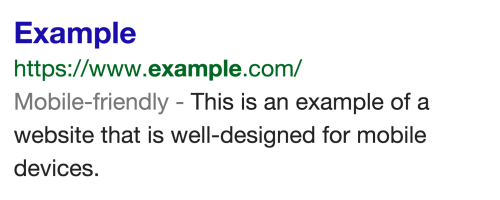
Today, April 21st, will be a trick or treat for internet business owners and webmasters as Google launches a significant mobile algorithm change. The purpose is to make Google’s search results more in tuned to what people are looking for. It’s been over 2 years since the last mobile ranking change. This update will impact only mobile searches in Google, and will NOT affect desktop or tablet searches.
Luckily this is not a delayed algorithm, therefore if you optimize your mobile site to Google’s liking soon, you should escape “Mobileggedon” and instead reap the benefits of increased mobile traffic.
What Does Google Look For in a Mobile Site?
Google classifies mobile sites as either mobile-friendly or non-mobile-friendly. If your site is already indexed by Google as mobile-friendly, then you will see a “mobile-friendly” label next to your site in the results, like so:

Enter your website URL into Google’s mobile-friendly testing tool to see if you meet the criteria. If you do, breathe a sigh of relief and enjoy the effects of this algorithm change. If your site failed the test, read on.
Your site will receive a “mobile-friendly” label if Googlebot sees the following:
- Avoids software that is not common on mobile devices, like Flash
- Uses text that is readable without zooming
- Sizes content to the screen so users don’t have to scroll horizontally or zoom
- Places links far enough apart so that the correct one can be easily tapped
My Site is Mobile Friendly. Now What?
Once you receive the mobile-friendly label, it’s time to further improve your mobile SEO. Google has helpfully created a page detailing common mistakes it often sees on mobile pages. Make sure your site doesn’t have any of the following:
- Blocked JavaScript, CSS and image files
- Unplayable content
- Faulty redirects
- Mobile-only 404s
- App download interstitials
- Irrelevant cross-links
- Slow mobile pages
That last one is especially crucial. Google has stressed that mobile websites should load in under a second. 40% of potential clients leave a site if it loads longer than 3 seconds. Thankfully Google provides tips and tools to help achieve that sub-one-second loading time.
click picture to enlarge
As the above picture shows, you have no control over the 600 milliseconds required for DNS lookup, TCP connection, and HTTP request and response time. However you do have control over the next 400 milliseconds of server response time and client side rendering. Google suggests performing the following:
- Have your above-the-fold content appear in milliseconds rather than seconds so the user is engaged while the rest of the site loads.
- The Server must render the response. Server response time is how long it takes for a server to return the HTML
- The number of redirects should be minimized. Ideally, you should eliminate redirects entirely. Avoid m.website.com redirects.
- The number of roundtrips to first render should be minimized. It is important to optimize content to minimize the number of roundtrips required to deliver the data needed to perform the first render of the page.
- Avoid external blocking JavaScript and CSS in above-the-fold content. You want to reduce the amount of network round trips, so remove any external scripts that must be downloaded, which add another network round trip.
- Reserve time for browser layout and rendering. The process of parsing HTML, CSS, and executing JavaScript can take up to 200 milliseconds depending on the complexity of the page.
- Optimize JavaScript execution and rendering time. Complicated scripts and code can take hundreds of milliseconds to execute properly.
Many of these practices can be automated. There’s numerous open source performance optimization tools that can help your site speed up.
Upon optimizing, test your mobile page and check your improvements with the PageSpeed Insights tool.
If you still have questions, perhaps this video will help, featuring members of Google’s webmasters team performing an hour Q-and-A session about the impending algorithm change.
Good luck tomorrow and in the future, and above all else, strive to give your users the best website experience possible.
[divider]
HostDime.com, Inc is a global data center infrastructure provider offering an array of cloud products from managed hosting servers to colocation services that cater to a range of clients, from entry-level to enterprise-level operations. HostDime owns and operates infrastructure and networks in seven countries, with its flagship facility in Florida, USA. Currently with a client base of more than 50,000, HostDime is one of the most reputable data center companies in the world.
Jared Smith is HostDime’s Content Strategist.

